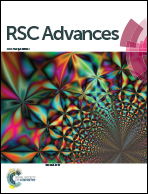Polymer electronic composites that heal by solvent vapour†
Abstract
Recent advances in organic electronic devices have reached new milestones in performance and function, and they are used in applications ranging from displays to sensory devices. However, they still present limitations in mechanical flexibility and electrical durability following the damage caused during their lifetime. Herein, we present a simple route to prepare conducting polymer composites that can address some of these issues through solvent vapour-induced healing of cracks formed within conducting polymer composites. Conducting polymer composites were prepared by solution blending of poly(3-hexylthiophene) (P3HT) and poly(dimethylsiloxane) (PDMS)-containing urea segmented copolymer. The bicomponent composites with various weight fractions of neutral P3HT were used to demonstrate their electroactivity whereas the electrical conductivity, mechanical and solvent vapour-induced self-healing studies were carried out with composites with various weight fractions of FeCl3-doped P3HT. A mechanically bisected free-standing film with 30 wt% of doped P3HT was observed to be readily healed through exposure to solvent vapour at room temperature, with a mechanical healing efficiency of 55 ± 24% and restoration of electrical conductivity up to 82 ± 1%.



 Please wait while we load your content...
Please wait while we load your content...